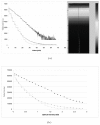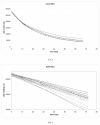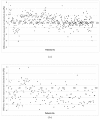Eight years of IMRT quality assurance with ionization chambers and film dosimetry: experience of the Montpellier Comprehensive Cancer Center
- PMID: 21774795
- PMCID: PMC3155475
- DOI: 10.1186/1748-717X-6-85
Eight years of IMRT quality assurance with ionization chambers and film dosimetry: experience of the Montpellier Comprehensive Cancer Center
Abstract
Background: To present the results of quality assurance (QA) in IMRT of film dosimetry and ionization chambers measurements with an eight year follow-up.
Methods: All treatment plans were validated under the linear accelerator by absolute and relative measures obtained with ionization chambers (IC) and with XomatV and EDR2 films (Kodak).
Results: The average difference between IC measured and computed dose at isocenter with the gantry angle of 0° was 0.07 ± 1.22% (average ± 1 SD) for 2316 prostate, 1.33 ± 3.22% for 808 head and neck (h&n), and 0.37 ± 0.62% for 108 measurements of prostate bed fields. Pelvic treatment showed differences of 0.49 ± 1.86% in 26 fields for prostate cases and 2.07 ± 2.83% in 109 fields of anal canal.Composite measurement at isocenter for each patient showed an average difference with computed dose of 0.05 ± 0.87% for 386 prostate, 1.49 ± 1.86% for 158 h&n, 0.37 ± 0.34% for 23 prostate bed, 0.80 ± 0.28% for 4 pelvis, and 2.31 ± 0.56% for 17 anal canal cases. On the first 250 h&n analyzed by film in absolute dose, the average of the points crossing a gamma index 3% and 3 mm was 93%. This value reached 99% for the prostate fields.
Conclusion: More than 3500 beams were found to be within the limits defined as validated for treatment between 2001 and 2008.
Figures






References
-
- Butler E, The BS, Grant WH. SMART (simultaneous modulated accelerated radiation therapy) boost: A new accelerated fractionation schedule for the treatment of head and neck cancer with intensity modulated radiotherapy. Int J Radiat Oncol Biol Phys. 1999;45:21–32. doi: 10.1016/S0360-3016(99)00101-7. - DOI - PubMed
MeSH terms
LinkOut - more resources
Full Text Sources
Medical

